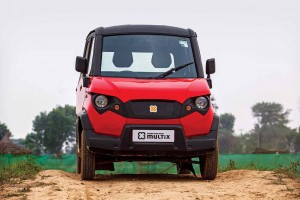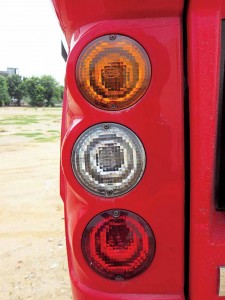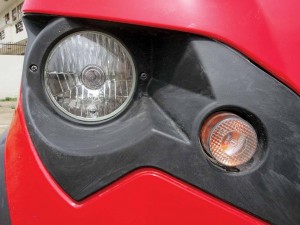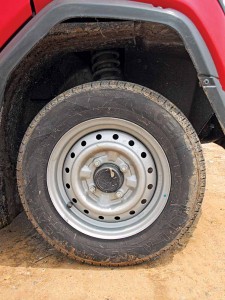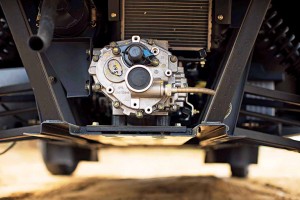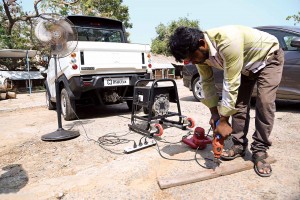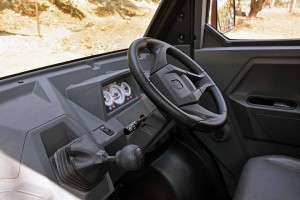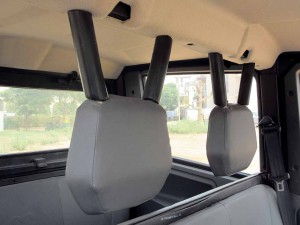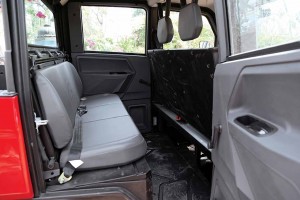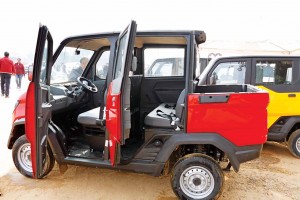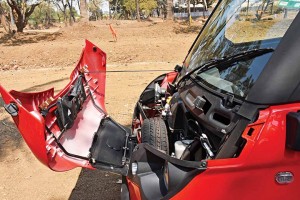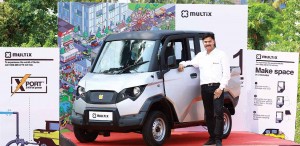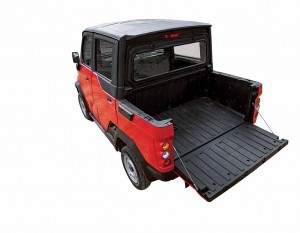The Multix seems to blur the line between a small commercial vehicle and a personal utility vehicle.
Story by: Anirudh Raheja
On a narrow winding road in the hinterland of Konkan, the Multix came as a surprise. Exiting a blind corner, on a rough country terrain that could hardly qualify as one, the Multix, with five adults and the cargo tray full of food grain sacks, made for an interesting sight. It looked dandy, and capable. It gave an impression of blurring the boundary between a personal utility vehicle and a small commercial vehicle. Introduced in 2015 by Eicher Polaris Pvt. Ltd (EPPL), a 50:50 joint venture between Eicher Motors and US-based Polaris, the Multix is finding takers for the versatility it offers. The number of Multix sold till date may be a little hard to ascertain, it for certain is showing signs of growing beyond the vision it was expected to live up to. Measuring 3235 mm in length, 1585 mm in width, and 1856 mm in height, the Multix was developed to start a new segment of independent businessmen as buyers. Those, looking for mobility, and a means to fulfill their business needs. Homologated under the category of personal vehicle, and a business vehicle by the Automotive Research Association of India (ARAI), the Multix, states CEO Pankaj Dubey, is a personal mobility vehicle.
Riding on 13-inch dia. wheels, and 155/80 R13 79T tubeless radial tyres, the Multix flaunts a 172 mm ground clearance. Subjected to extensive testing in India and the US of over 18 lakh kilometres, the vehicle borrows from Polaris’ expertise in building ATVs and side-by-sides. The vehicle also borrows from Eicher’s expertise in building two wheelers, tractors and commercial vehicles. Developed to tap a population of 5.8 crore independent businessmen, the Mutix makes a strong case to combine business with pleasure.
Business and pleasure
The sales of Multix may tilt in the favour of ‘white plate’ personal vehicle, its preference as a ‘yellow plate’ commercial vehicle is rising. Subjected to off-road durability, reliability and safety tests, the vehicle can be registered as either. For commercial application the preference is expected to be for the AX+ variant, which has a kerb weight of 683 kg (GVW is 1150 kg), and is priced at Rs.2.43 lakh ex-showroom approximately. Closer to the original design, and developed with an intention to address the needs of those that will indulge in multiple usage, the AX+, sans the doors, would make more room for passengers. Mentions Dubey, “The original design (AX+) we created was a primary model without doors. On the basis of customer feedback and our research, doors were added. This resulted in the MX.” The doors of the MX are made from Flexituff, a light-weight material that the company has patented. The bonnet of the Multix is also made from this material. It is according to Dubey, highly durable, resistant to rust, and easy to repair. If the AX+ and MX will meet the crash norms that are expected to be rolled out next year, Dubey avers, “It is debate-able to apply passenger vehicle crash norms to a vehicle that has a top speed of less than 60 kmph. Since we have to, we will adhere to the norms.” The MX is priced at Rs.2.82 lakh ex-showroom approximately, and weighs 775 kg. Its GVW is the same as AX+ at 1150 kg.
On par in terms of load carrying capacity with many small commercial vehicles available in the market, according to Dubey, the Multix, states Dubey, offers a distinct advantage of independent suspension. Termed as Pro-ride, the suspension is made up of hydraulic McPherson struts at front, and double wishbones at the rear. Drive is routed to the rear wheels through a four-speed constant mesh gearbox. Capable of clocking better speeds over less than ideal surfaces should make the Multix appealing to those that transport perishable commodities like vegetables and fruits. Designed to sustain up to 20 per cent more than the specified storage capacity of 418.3 kg, the possibility of overloading is never far away, the vehicle, with the glass partition between the cargo bay and the cab dismantled, can offer a cavernous 840-litre storage capacity. The rear seats are foldable.
If the appearance and dimensions of the Multix make it appear unique, a strong tubular chassis is at the core. The body panels are a combination of flexituff material and steel. Offering unique engineering attributes like Power Take Off (PTO), which is called Xport, and can help power a generator or a water pump among other utilities with the help of a PTO shaft sold as an accessory, the Multix, Dubey elaborates, seeps less than one-litre of diesel per hour. Capable of generating three kilo-watt power in less than five minutes, the vehicle has a 11.5-litre fuel tank. Making for a 12-hour operation for a PTO linked utility, the Multix comes across as versatile. Affected by demonetisation because of high reliance on cash in rural and semi-rural areas, the Multix has turned its attention to urban buyers. Its ability to play the role of a commercial vehicle is drawing attention. The pan-India migration to BSIV has helped ther Multix to look at newer avenues and opportunities, to grow. The move to BSIV triggered a 20 per cent rise in the cost, says Dubey. He mentions, “The incorporation of EGR technology led to an increase in the cost.” Looked upon as an investment by a small businessman, the increase in cost is proving to be a challenge. Buyers are unable to understand the reason behind the cost increase, says Dubey. While new ways are being found to make the buyer understand, EPPL, to ensure a smooth transition, ceased the production of BSIII Multix in Februrary 2017. In March, BSIV Multix production was started. Some BSIII vehicles have been left over at the dealer level. EPPL, states Dubey, is taking care of these.
Continuous improvement
Made at a modern manufacturing plant at Kukas, Rajasthan, spread over an area of 25 acres, and with an annual production capacity of 60,000 units, the Multix is subjected to stringent quality checks. With stress on continuous product improvement, a cell of 40 engineers, according to Dubey looks into customer demand and feedback. Necessary changes are incorporated to improve the quality and value. To ensure high manufacturing standards, the Multix is built with the aid of robotic weld lines, a modern paint shop, and a final assembly line. It will not be an exaggeration to describe the manufacturing facility to be almost as flexible as the vehicle. Mentions Dubey, the design flexibility of the Multix is a double-edged sword. It makes it highly versatile, but also leads to some limitations, expresses Dubey. He adds, “The roll-cage, which elevates safety, covers 70 per cent of the body structure, also poses certain limitations.” The roll cage is said to pose certain restrictions in making signtificant design changes to arrive at a open-top version, and a single-cab version. “Based on business requirements we will take a call,” quips Dubey.
Pursuing growth
Financed by leading private and public sector banks, and NBFCs, the Multix is sold through a pan-India network of 76 dealers. Network expansion is underway, and three new dealerships at Delhi, Faridabad and Thane were recently commissioned. EPPL plans to bridge the 100 dealership mark by the end of this year. The target for next year is 150 dealers. Entry into urban markets like Delhi has created a need to offer a CNG version. EPPL is seeding a CNG model, but will take time to launch it. It is perhaps the need to expand the network to CNG markets to offer the right support. Avers Dubey, that a centre close to the customer plays a big role in satisfying his needs.
Having clocked 20 per cent growth last year, EPPL is hoping for a stronger growth this year. It is betting on market reach, and the availability of BSIV model, to enhance the urban thrust. The need, says Dubey, is to be certain. Uncertainty is not healthy for business,” he avers. Eyeing the exports markets of Nepal and Bangladesh, and in discussion for export to central American countries, EPPL is looking at many new avenues of growth. The simple yet dandy workhorse nature of the Multix should make it appealing. Seen in flesh, the Multix, with the front dominated by a steeply rising bonnet, does look purpose-built. The head lamps and parking lamps are recessed, and separated by a faux grille. The bumper doubles up as a moulding that runs along the lower portion of the body.
If the large windscreen with a single wiper adds to the tall-ish looks of the Multix, the overall impression is of a semi-forward cab layout. A rising window-line and wheel arches define the sides, and endorse the wedge-shape. The greenhouse and wheel arches, finished in a shade of black, add a touch of style. The rear is made up of a large trunk lid, held in place by two latches. The tail lamps are built into the rear pillars. Visible under the rear floor, and fitted snugly in the tubular chassis is an air-cooled single cylinder direct-injection G650 W Greaves Cotton engine. It belts out 13.4 PS (9.85kW) of power and 37 Nm of peak torque at 1600-2000 rpm. Power is routed through a four-speed constant mesh gearbox. The PTO juts out of it.
The Drive
The wide opening doors make for easy access. The large windscreen and ample glass area makes for good visibility. The simple dash, made up of a combination of lines, includes an instrument panel containing a speedo, and a fuel and temperature gauge. The gear lever juts out of what could be described as the centre console. The bench seat presents the possibility to seat three people at front. It provides fair amount of support. The rear bench seat can seat three people. The amount of room available is fair. An amount of noise accompanies the starting of the engine. The Multix may not score high in refinement when compared to cars, vibrations are well contained. Moving away from standstill, the Multix may not quickly gain speed, it presents a feel of being a tough workhorse. The tall first cog amply hints at a workhorse orientation. The second and third cogs bring some speed to the vehicle. Good momentum is achieved in the fourth gear. Speeds in the region of 50 kmph are achieved. A race against the clock is not the Multix forte. Rather than speed, the ability of the vehicle to lug impresses. If this make the Multix fit to be a commercial vehicle, its flexible nature impressesive, no less.
The ride is superior to that of a mini-truck. Less than ideal surfaces are displaced with ease. Bad stretches fail to discomfort the occupants. Handling is good, and the steering feels direct and precise. The need for a power steering is felt though. With an impressive ability to maneouvre through narrow spaces, the Multix with a turning radius of 3.93 m, offers 27.8 kmpl mileage under standard test conditions. Offering good fuel efficiency, the Multix costs as much as a small commercial vehicle would. Its tractor-like ability to power utilities through a PTO is an added advantage. The move to BSIV may have increased the price of the Multix, its ability to offer superior flexibility makes it appealing.
Pankaj Dubey, Chief Executive Officer, Eicher Polaris Pvt. Ltd.
Q. What makes the Multix stand out?
A. It is targeted at businessmen who can use it for personal as well as business purpose. The vehicle can be used to carry passengers, and to move cargo. With a number of vehicles available in the market for load carrying, we may not be the best, we are however on par with some of them. Offering the comfort of independent suspension all round, the biggest USP of the Multix is the comfortable drive it offers. For those carrying perishable goods, or goods that may get spoilt due to road shocks, the Multix offers a solution. It offers a safe transit for products which are sensitive to bad roads.
Q. What about the load carrying capacity?
A. The payload capacity of the Multix is 450 kgs. Raising it by 15 to 20 per cent would not be an issue. We have come across customers who have claimed to carry 900 kg of cargo with ease. We do not support any form of overloading however, and it should be avoided at all costs for an improved ecosystem.
Q. What led to the development of the Multix?
A. We designed the Multix with a sole objective to serve customers that are looking at multiple usage. The Multix can perform various tasks, and deliver a fuel efficiency of 27-30 kmpl. It is equivalent to that of a two wheeler. When not carrying load, the Multix can be used as a five-seater car. Two-wheeler owners can have a bigger vehicle in the form of the Multix. They can have a vehicle that is comfortable, and saves them from weather changes.
Q. What went into the development of the Multix?
A. Both, Polaris and Eicher, combined their strengths to develop the Multix. Eicher brought in the PTO; Polaris brought in its ability to create a new segment and innovate. The Multix is an indigenous product. Its design is localised. It has been also developed locally. Eicher contributed to its cost effective development too. A Polaris contribution, the Multix employs flexituff material, which keeps the weight down. The contribution of both the partners ensured that the Multix would address the customer requirements. It is designed with a roll cage bar that covers up to 70 per cent of the vehicle area.
Q. The role the R&D played in the development of the Multix?
A. The R&D at Eicher Polaris comprises of a team of 40 engineers that look after product improvement, stimulation testing and development of a number of applications that a customer would like to see in the Multix. The team also looks at finding new solutions based on customer feedback. A lot of development is taking place, and includes an effort to make the Multix lighter, and more capable. The testing of Multix for new applications like transportation of liquids is carried out by the R&D. The R&D division is also developing and testing variants that would better fulfill the changing needs of the customers. There is a demand for open-top vehicle, and for a single cab version. A ‘flexi’ design, there are certain areas that are posing a challenge. The roll cage covers nearly 70 per cent of the vehicle, reducing the rear space. We are evaluating feedback received, and are carrying out feasibility tests based on the business needs.
Q. What is the homologation type of the Multix?
A. Mulitx has undergone homologation as a personal vehicle, and as a business vehicle too, at the ARAI. It can be registered as a yellow plate CV and a white plate personal vehicle depending upon the nature of its application. As for now, the demand for white plate Multix is more than that for the yellow plate. The demand for yellow plate is however rising.
Q. What is the difference between the MX and AX+ version?
A. The original design that we created was the AX. It was to be the primary model. Research and customer feedback however revealed that doors were necessary to better integrate the design. Both the MX and AX+ have similar features. The AX+ is more open and can be used for transport in rural areas where mobility is an issue. Equipped with a PTO, which is called the Xport, a feature that is common to tractors, the Multix could help to operate a number of agricultural units. An energy of three kilo-watts could be generated.
Q. Amid the talk of crash norms implementation, how do you see the Multix faring?
A. The top speed of the Multix is less than 60 kmph. To expect it to meet the norms that are applicable to cars that achieve much higher speeds is debatable. We have to adhere to them, and we will. It is a challenge that we are working on. Many changes, including the move to BSIV emission norms, and demonetisation happened in a short duration. This has brought about an amount of uncertainty, which is not healthy for the business. A number of rules are expected in the next few years, and will call for an amount of work. Both the versions of the Multix are offered with an accessory that turns them into a fully integrated vehicle for secure cargo movement.
What changes has the Multix undergone to comply with BSIV emission norms?
This being a low-speed vehicle makes it more challenging. We have introduced EGR. The exhaust gases are recirculated into the system. To comply with BSIV emission norms, we added various things like the ECU controller as well. The changes have led to a cost increase of 20 per cent. For a small businessman, even a vehicle like this is an investment. It is therefore proving to be a difficult task to make him understand.
Q.Is the demand for an alternate fuel Multix rising?
A. We have not seen much demand for alternate fuels. We have been present in small towns where availability of fuels like CNG is low. After introducing the Multix in markets like Delhi and Ghaziabad, we have started hearing the need for CNG variants. We are not in favour of introducing an alternate fuel version soon.
Q. How many Multix are produced? What is the plant capacity?
A. The Multix is produced at a modern plant at Kukas, Rajasthan. There are robots that carry out welding in the weld shop. The entire plant was developed in-house. The current capacity of the plant is 60,000 units, and can be scaled up to 1.2 lakh units depending on the market demand. Currently, we are producing the Multix in a single shift., which can see increase in shifts. But again, it depends on the demand. We are supported by 104 vendors with whom we are working on cost optimisation.
Q. What was the effect of demonetisation? The changes GST would bring?
A. The impact of demonetisation was felt in rural India since most of the transactions are cash intensive. That was felt for a few months, and continues to be in the the minds of the people. The migration to BSIV has pushed up costs. It is a concern that we and our customers share. The value that the customer sees is not very high. He is not ready to understand the reason that made the same vehicle, which was cheaper a few months back, costly. There’s been an impact, and will continue until people do not understand that price increase was inevitable. To ensure smooth transition, we did not produce any BSIII vehicle in the month of March. We started producing BSIV vehicles instead, and began our supply of BSIV vehicles to the dealers. Our dealers are left with a few BSIII vehicles, and we need to take care of those.
Q. What is your current dealer strength?
A. We have 76 dealers. By the end of this year, the number will rise to more than 100 dealers. We plan to elevate the dealer strength to 150 over the next one year. With BSIV in, we are looking at an all-round growth. We are closely monitoring the markets like Thane, Delhi and Faridabad, which we have just entered. These, we feel, will help us to gauge customer appetite. If Tier-one cities respond positively, we will get a head room to expand our reach. Since after sales support also plays a big role, and customers want a center closer to their area of operation. We are looking at strategies that will help us to address customer needs. All our dealers sell as well as service the Multix. We have also tied-up with a RSA to quickly address a complaint.
Q. What growth are you anticipating? What about exports?
A. This year we are growing at 20 per cent. Our aim is to double the growth next year. There are 13 big towns in India – big business centers, where we were not present. They are now our focus area as far as market reach is concerned. We recently began exporting the Multix to Nepal. We will soon find our way to Bangladesh. We are also looking into inquiries received from central American countries. Talks are on.



